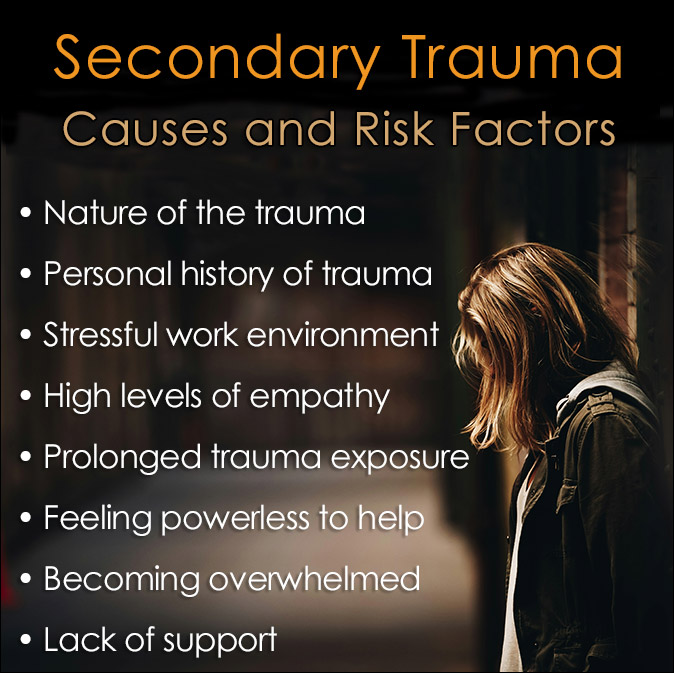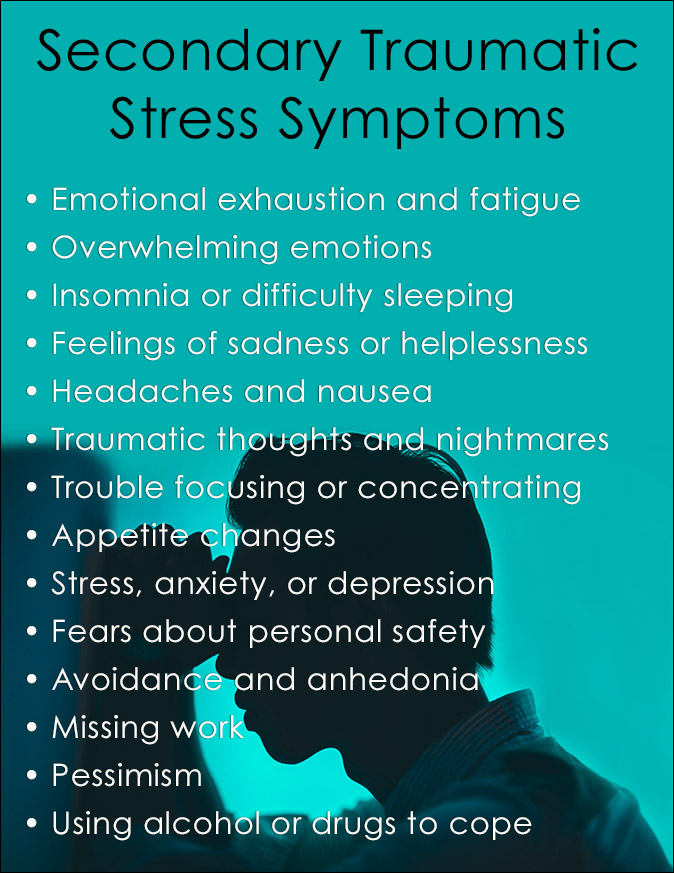
Secondary Trauma, also known as Secondary Traumatic Stress, is a mental health issue that affects individuals who are indirectly impacted by traumatic events.
It is a unique condition because those who experience it did not directly encounter the trauma causing the symptoms they struggle with.
Even though they didn’t live through the stress and anxiety of a traumatic event, the symptoms are the same as those encountered with post-traumatic stress and other types of trauma disorders.
Understanding the causes, symptoms, and treatment options is necessary for those living with secondary trauma and also the healthcare workers, therapists, and family members who help them recover.
What is Secondary Trauma?
Secondary trauma can be defined as a condition that causes negative emotional distress symptoms similar to PTSD and trauma disorders that are caused by exposure to the traumatic experiences of others.
It is also known by the following names:
- Vicarious Trauma
- Secondary Traumatic Stress
- Second Hand Stress
- Compassion Fatigue
It is sometimes called vicarious trauma because it affects those who are in close contact with individuals who have experienced trauma themselves.
Secondary trauma is a natural emotional response that occurs from working with trauma victims and should not be viewed as a sign of weakness.
The condition commonly affects therapists, social workers, healthcare providers, and educators who work closely with trauma survivors, but it can also have an impact on friends and family members.
It is most prevalent when there is a deep, personal connection with trauma survivors or when an individual is repeatedly exposed to the second hand details of a traumatic event.
It’s human nature to have compassion and empathy for those who we care about, or we are helping to heal and recover. Therefore, the feelings of emotional distress are easily transferred from one person to another as compassion fatigue.
When working with trauma survivors, it’s necessary for healthcare providers and family members to identify the symptoms of secondary traumatic distress they may be experiencing in their own lives and take steps to address them.
What Causes Secondary Trauma?
The primary cause of secondary trauma is usually due to a close or empathetic relationship to the emotional difficulties experienced by a trauma survivor.
Even indirect exposure to traumatic events can have a profound effect on a person’s mental state, especially when they are exposed over a long period of time and they are emotionally invested in another person’s well being.
The second hand nature of vicarious trauma can be just as complex as personally experiencing a traumatic event and there are certain factors that may increase the risks of developing the condition.

Secondary Trauma Causes and Risk Factors Include:
- Nature of the traumatic events
- Personal history of trauma
- Stressful work environment
- High levels of empathy
- Prolonged exposure to trauma
- Feeling powerless to help
- Becoming overwhelmed
- Professional lack of support
Therapists and healthcare workers with a personal history of trauma face a higher risk of developing secondary trauma from triggering past memories.
Having empathy is beneficial for helping others to heal and recover although it can increase the vulnerability of experiencing the same symptoms faced by the patients.
Stressful work environments and continuous exposure to traumatic events can also increase the risks.
According to Dr. Bessel van der Kolk, for people who help others overcome trauma, it’s crucial to have a supportive network to talk and connect with to reduce the chances of experiencing vicarious trauma.
It’s sometimes necessary for trauma therapists to undergo therapy to take care of their own mental health needs so they can be emotionally available to the demands of their patients.
Secondary Trauma Symptoms
The symptoms of secondary trauma will be different for each individual and may vary in severity based on a number of factors.
The signs of secondary traumatic stress are similar to those experienced with many types of PTSD and treatment often follows the same approaches.
The symptoms can cause physical, emotional, behavioral, or cognitive difficulties and may play a significant role on an individual’s personal and professional life.
Secondary Traumatic Stress Symptoms include:
- Emotional exhaustion and fatigue
- Overwhelming emotions
- Insomnia or difficulty sleeping
- Anger and irritability
- Feelings of sadness or helplessness
- Headaches
- Nausea and stomach issues
- Traumatic thoughts and images
- Nightmares
- Trouble focusing or concentrating
- Physical or mental numbness
- Appetite changes
- Stress, anxiety, or depression
- Fears about personal safety
- Avoidance
- Despair or hopelessness
- Anhedonia or inability to feel pleasure
- Missing work
- Pessimism
- Personal relationship struggles
- Using alcohol or drugs to cope
Being able to identify and recognize these signs in oneself or others and seeking help when they appear is crucial for treating the symptoms.

Treatment for Secondary Trauma
It’s important for individuals struggling with secondary trauma to seek help and support as early as possible for treatment to be effective.
With proper therapy and self-care strategies, it’s possible to manage the symptoms of secondary traumatic stress and continue to make a positive impact in the lives of others.
Secondary trauma treatment often requires a comprehensive approach that combines evidence-based therapies with holistic and lifestyle activities for healing and recovery.
Effective treatment can include a combination of the following:
- Cognitive Behavioral Therapy (CBT)
- Eye Movement Desensitization and Reprocessing (EMDR)
- Exposure Therapy
- Self-Care
- Social Support
- Mindfulness and Relaxation Techniques
- Neurofeedback Therapy
- Somatic Experiencing Therapy for Trauma Healing
- Yoga
Cognitive Behavioral Therapy (CBT) is a powerful tool for addressing the negative thought patterns and beliefs that can arise from secondary trauma exposure. It teaches individuals to identify and challenge negative or distorted thoughts and replace them with healthier perspectives.
CBT also teaches coping skills like relaxation, mindfulness, and problem-solving to manage stress and regulate emotions.
Eye Movement Desensitization and Reprocessing (EMDR) is an evidence-based therapy that helps the brain process and integrate past traumatic memories that have become stuck.
It combines bilateral stimulation with revisiting the traumatic memory in brief doses. This activates the brain’s information processing system and allows memories to be stored in a healthier and less stressful manner.
EMDR therapy can provide long-term relief from intrusive thoughts, emotional distress, and other secondary trauma symptoms related to working on specific cases or interactions with patients.
Exposure Therapy provides a gradual, controlled way to confront trauma in a supportive therapeutic environment. Avoidance is a common reaction to secondary trauma that reinforces fears and anxiety.
Exposure helps to better tolerate distress and reduce anxiety, and this type of therapy integrates well with CBT for a comprehensive approach.
Neurofeedback helps regulates emotions and the automatic stress response caused by trauma that often leads to anxiety or depression.
Somatic Experiencing Therapy is a body-centered grounding method that helps to resolve secondary trauma symptoms and to moderate the somatic response associated with the autonomic nervous system.
Self Care strategies include regular exercise, healthy nutrition, getting proper sleep, practicing meditation and mindfulness, enhancing social support, and balancing the demands of work and life.
While many types of therapies address the psychological impact of secondary trauma, self-care activities improve resilience, perspective, and boundaries that can be become broken from working with stressful nature of trauma disorders.
Boosting resilience is an ongoing process of self-awareness and self-compassion to empower professionals to protect their own well-being while helping trauma survivors recover.
Behavioral therapies and self-care activities are beneficial for processing the challenges associated with secondary trauma exposure.
Healing and recovery can be found by changing negative thought patterns, confronting fears, integrating traumatic memories, and cultivating resilience through compassionate self-care.
Related Posts
- Complex PTSD Symptoms, Causes and CPTSD Treatment
Complex PTSD symptoms are closely related to those of post-traumatic stress disorder although there are…
- Learned Helplessness Causes, Symptoms and Treatment
Learned helplessness is a condition that occurs when an individual feels helpless and unable to…
- 5 Types of PTSD and Treatment Therapy
Anyone can experience post-traumatic stress disorder symptoms and recognizing the different types of PTSD will…
